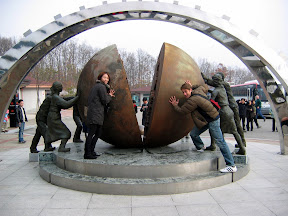The 38th Parallel
I am not much for tours. I like doing touristy things at times while traveling of course, but the thought of piling in and out of a bus and anything involving a blow horn or following a flag sends me running. But in the case of Korea, my interest in seeing the Demilitarized Zone trumped my adversity to tours. If you want to see it, you have to go on a tour. It makes sense, I guess. You can’t have a bunch of camera wielding tourists traipsing about the world’s most heavily armed, semi-active war zone border. So we signed up to see this cold war throwback, a no-man’s land untouched for over 50 years.
The first thing you feel when you approach the 38th parallel is the cold. It’s strange to think that other cities that share this latitude are San Francisco and Athens, but the Asian weather system keeps Korea in the cold, often taking the frigid Siberian cold front in full force. Aside from the temperature, the place seems frozen in time. Roads get smaller, traffic all but disappears, and suddenly you realize you are driving along a very long fence. Painted white rocks are intricately placed within the cyclone fencing. More rocks, each with a thin red stripe, are stacked carefully on small bolted brackets to indicate even the slightest movement in the fence. This low-tech detection method left me wondering how they could tell the difference between a stiff wind and the North Korean 1st Infantry. Our guide, CK (crazy Korean [haha]), explained that it doesn’t really matter as this is a shoot first, ask questions later kind of place.
There are two fences on each side and in between is the DMZ, almost 2 kilometers across, and home to a richness in biological diversity unknown in any other temperate zone on Earth. When I say unknown, I mean it. Until future reunification comes, it remains unstudied what happens when flora and fauna are given free reign in such a huge area of land. Luckily it is mostly birds that have taken over, because bears would have a tough time contending with all the landmines.
We were not allowed to enter the “DMZ proper” on this tour. If you’re willing to pay for it you can visit Panmunjeom village which lies a stone’s throw from the stone-faced North Korean soldiers on the other side of the fence. Our tour’s highlight was the 3rd infiltration tunnel running 1600 meters under the DMZ. If remained undetected it could have flowed 30,000 troops per hour across the border, a mere 52 km from Seoul.
We entered through a tunnel built for the booming DMZ tour industry. The 3rd tunnel is 73 meters below ground and quite elaborate. We were allowed to follow it for about 300 yards before being forced back by the hermetically sealed doors, the first defense from subterranean invasion. As the North Koreans dug through solid rock, they rubbed coal into the walls to give themselves the mining excuse if detected. When the South finally did find the tunnel in 1978, the North made all kinds of wild excuses from coal exploration to accusing the South of building it, despite obvious south-pointing drill marks. North Korea finally admitted as much to building the tunnel last year when they petitioned Seoul for compensation. Pyongyang is well aware that the DMZ has become the number one tourist attraction in Korea and had the audacity to ask for some retribution for the tunnel they built, or rather their political prisoners built. It’s just another example of the North’s strange and desperate behavior.
The tunnel is interesting enough, but in the end it’s just a tunnel. A 4th tunnel was found in 1990, and despite the two Korea’s rosier relations as of late, I wouldn’t doubt the discovery of a 5th down the line.
Other stops on the tour included Dorasan military observatory and Dorasan rail station, both with strict picture policies. Dorasan station is a brand new beautiful building that remains completely empty. This is the last stop and few get off here. It has been built in anticipation of reunification and touts itself as a possible major stop on a future Trans-Korean express; Seoul to Moscow via Pyongyang. The area around the station is bustling with construction. Hyundai is building factories and tourist infrastructure, all in hope that someday Korea will once again be one. I wonder if they know something we don’t.
The tour wasn’t what I hoped, but much of what I expected. It was rushed, involved blow horn announcements to get on the bus, and didn’t live up to the promises in the flyer. I wouldn’t go so far to say it was a waste of time or money however. If you are interested in geopolitics, the DMZ has it’s fascinating moments. Most interesting is the tone and rhetoric of the place. No longer is blatant propaganda geared toward division. Everything about the place screams that Korea is on a course toward reunification. Whether this is true is unknown, but I found it interesting to find that although North Korea has increasingly isolated itself from the world community, Kim Jong Il’s government has been far more open with Seoul than his father’s.
If you’ve seen the sites in Seoul and need a day to fill, the DMZ is worthwhile, but shouldn’t be a high priority on a packed Korea itinerary.
Tags: Capitals tour of Asia, Korea


Leave a Reply